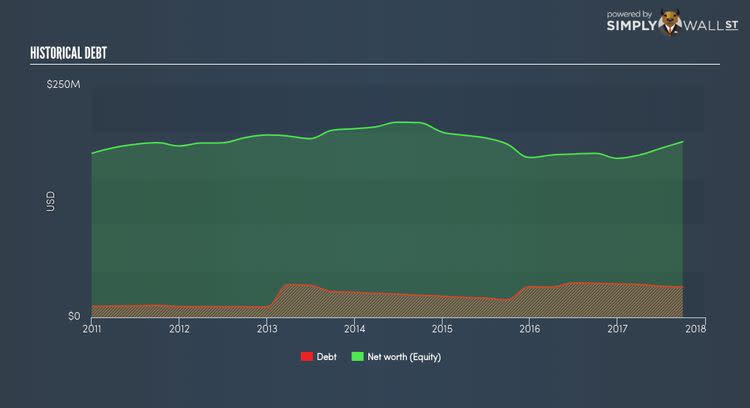How Financially Strong Is Vishay Precision Group Inc (VPG)?

Investors are always looking for growth in small-cap stocks like Vishay Precision Group Inc (NYSE:VPG), with a market cap of USD $331.62M. However, an important fact which most ignore is: how financially healthy is the company? The significance of doing due diligence on a company’s financial strength stems from the fact that over 20,000 companies go bankrupt in every quarter in the US alone. Here are few basic financial health checks to judge whether a company fits the bill or there is an additional risk which you should consider before taking the plunge. See our latest analysis for VPG
How does VPG’s operating cash flow stack up against its debt?
While failure to manage cash has been one of the major reasons behind the demise of a lot of small businesses, mismanagement comes into the light during tough situations such as an economic recession. These catastrophes does not mean the company can stop servicing its debt obligations. Fortunately, we can test the company’s capacity to pay back its debtholders without summoning any catastrophes by looking at how much cash it generates from its current operations. VPG’s recent operating cash flow was 0.6 times its debt within the past year. This is a good sign, as over half of VPG’s near term debt can be covered by its day-to-day cash income, which reduces its riskiness to its debtholders.
Can VPG pay its short-term liabilities?
In addition to debtholders, a company must be able to pay its bills and salaries to keep the business running. During times of unfavourable events, VPG could be required to liquidate some of its assets to meet these upcoming payments, as cash flow from operations is hindered. We test for VPG’s ability to meet these needs by comparing its cash and short-term investments with current liabilities. Our analysis shows that VPG is able to meet its upcoming commitments with its cash and other short-term assets, which lessens our concerns for the company’s business operations should any unfavourable circumstances arise.
Can VPG service its debt comfortably?
Debt-to-equity ratio tells us how much of the asset debtors could claim if the company went out of business. In the case of VPG, the debt-to-equity ratio is 17.41%, which indicates that its debt is at an acceptable level. We can test if VPG’s debt levels are sustainable by measuring interest payments against earnings of a company. Ideally, earnings should cover interest by at least three times, therefore reducing concerns when profit is highly volatile. VPG’s profits amply covers interest at 13.92 times, which is seen as relatively safe. Debtors may be willing to loan the company more money, giving VPG ample headroom to grow its debt facilities.
Next Steps:
Are you a shareholder? VPG’s high cash coverage and low debt levels indicate its ability to utilise its borrowings efficiently in order to generate ample cash flow. In addition to this, the company will be able to pay all of its upcoming liabilities from its current short-term assets. Moving forward, its financial position may change. I suggest keeping on top of market expectations for VPG’s future growth on our free analysis platform.
Are you a potential investor? VPG’s relatively safe debt levels is even more impressive due to its ability to generate high cash flow, which illustrates operating efficiency. Moreover, its high liquidity ensures the company will continue to operate smoothly should unfavourable circumstances arise. To gain more conviction in the stock, you need to further analyse the company’s track record. I encourage you to continue your research by taking a look at VPG’s past performance analysis on our free platform to figure out VPG’s financial health position.
To help readers see pass the short term volatility of the financial market, we aim to bring you a long-term focused research analysis purely driven by fundamental data. Note that our analysis does not factor in the latest price sensitive company announcements.
The author is an independent contributor and at the time of publication had no position in the stocks mentioned.

